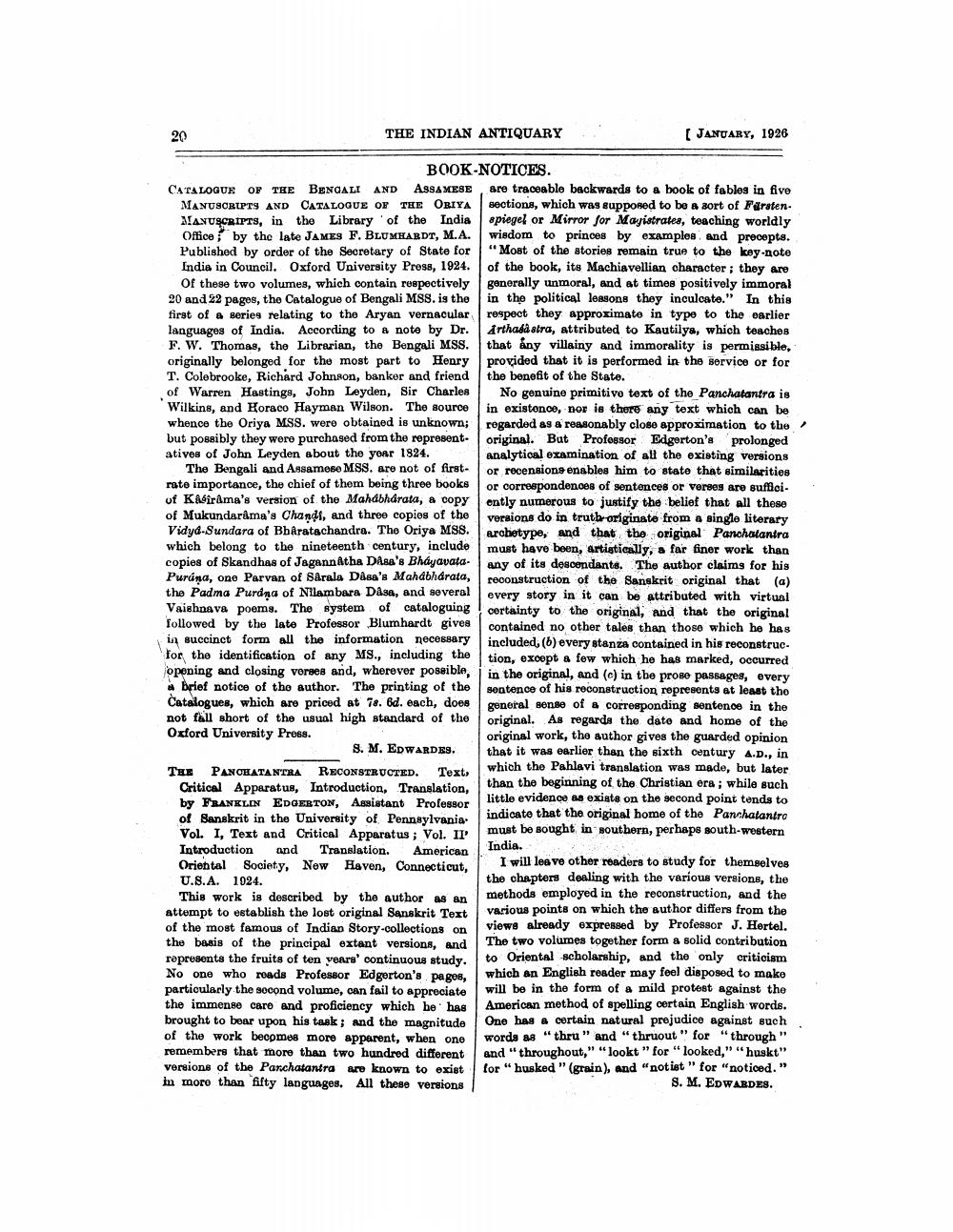________________
20
THE INDIAN ANTIQUARY
BOOK-NOTICES.
CATALOGUE OF THE BENGALI AND ASSAMESE MANUSCRIPTS AND CATALOGUE OF THE ORIYA MANUSCRIPTS, in the Library of the India Office by the late JAMES F. BLUMHARDT, M.A. Published by order of the Secretary of State for India in Council. Oxford University Press, 1924. Of these two volumes, which contain respectively 20 and 22 pages, the Catalogue of Bengali MSS. is the first of a series relating to the Aryan vernacular languages of India. According to a note by Dr. F. W. Thomas, the Librarian, the Bengali MSS. originally belonged for the most part to Henry T. Colebrooke, Richard Johnson, banker and friend of Warren Hastings, John Leyden, Sir Charles Wilkins, and Koraco Hayman Wilson. The source whence the Oriya MSS. were obtained is unknown; but possibly they were purchased from the represent atives of John Leyden about the year 1824.
The Bengali and Assamese MSS. are not of firstrate importance, the chief of them being three books of Kaéirama's version of the Mahabharata, a copy of Mukundarama's Chandi, and three copies of the Vidya-Sundara of Bharatachandra. The Oriya MSS. which belong to the nineteenth century, include copies of Skandhas of Jagannatha Dasa's Bháyavata. Purana, one Parvan of Sarala Dasa's Mahabharata, the Padma Purdna of Nilambara Dasa, and several Vaishnava poems. The system of cataloguing followed by the late Professor Blumhardt gives in succinct form all the information necessary for the identification of any MS., including the opening and closing verses and, wherever possible, a brief notice of the author. The printing of the Catalogues, which are priced at 78. 6d. each, does not fall short of the usual high standard of the Oxford University Press. S. M. EDWARDES. THE PANCHATANTRA RECONSTRUCTED. Text, Critical Apparatus, Introduction, Translation, by FRANKLIN EDGERTON, Assistant Professor of Sanskrit in the University of Pennsylvania. Vol. I, Text and Critical Apparatus; Vol. II' Introduction and Translation. American Oriental Society, New Haven, Connecticut, U.S.A. 1924.
This work is described by the author as an attempt to establish the lost original Sanskrit Text of the most famous of Indian Story-collections on the basis of the principal extant versions, and represents the fruits of ten years' continuous study. No one who reads Professor Edgerton's pages, particularly the second volume, can fail to appreciate the immense care and proficiency which he has brought to bear upon his task; and the magnitude of the work becomes more apparent, when one remembers that more than two hundred different versions of the Parchatantra are known to exist in more than fifty languages. All these versions
[ JANUARY, 1926
are traceable backwards to a book of fables in five sections, which was supposed to be a sort of Fürstenspiegel or Mirror for Magistrates, teaching worldly wisdom to princes by examples and precepts. "Most of the stories remain true to the key-note of the book, its Machiavellian character; they are generally unmoral, and at times positively immoral in the political lessons they inculcate." In this respect they approximate in type to the earlier Arthadastra, attributed to Kautilys, which teaches that any villainy and immorality is permissible, provided that it is performed in the service or for the benefit of the State.
No genuine primitive text of the Panchatantra is in existence, nor is there any text which can be regarded as a reasonably close approximation to the original. But Professor Edgerton's prolonged analytical examination of all the existing versions or recensione enables him to state that similarities or correspondences of sentences or verses are sufficiently numerous to justify the belief that all these versions do in truth originate from a single literary archetype, and that the original Panchatantra must have been, artistically, a far finer work than any of its descendants. The author claims for his reconstruction of the Sanskrit original that (a) every story in it can be attributed with virtual certainty to the original, and that the original contained no other tales than those which he has included, (b) every stanza contained in his reconstruc. tion, except a few which he has marked, occurred in the original, and (c) in the prose passages, every sentence of his reconstruction represents at least the general sense of a corresponding sentence in the original. As regards the date and home of the original work, the author gives the guarded opinion that it was earlier than the sixth century A.D., in which the Pahlavi translation was made, but later. than the beginning of the Christian era; while such little evidence as exists on the second point tends to indicate that the original home of the Panchatantro must be sought in southern, perhaps south-western India.
I will leave other readers to study for themselves the chapters dealing with the various versions, the methods employed in the reconstruction, and the various points on which the author differs from the views already expressed by Professor J. Hertel. The two volumes together form a solid contribution to Oriental scholarship, and the only criticism. which an English reader may feel disposed to make will be in the form of a mild protest against the American method of spelling certain English words. One has a certain natural prejudice against such words as "thru" and "thruout" for "through" and "throughout," "lookt " for "looked," "huskt" for "husked "(grain), and "notist" for "noticed. " S. M. EDWARDES.
"




